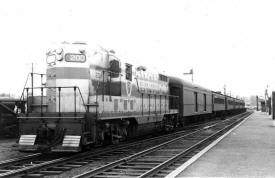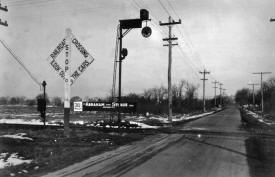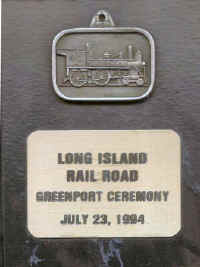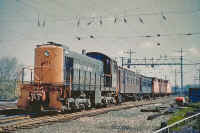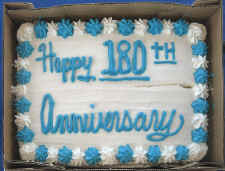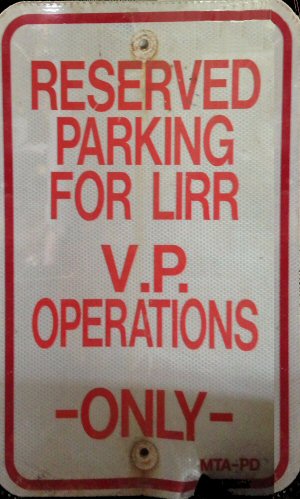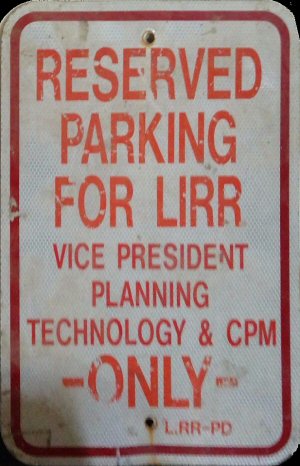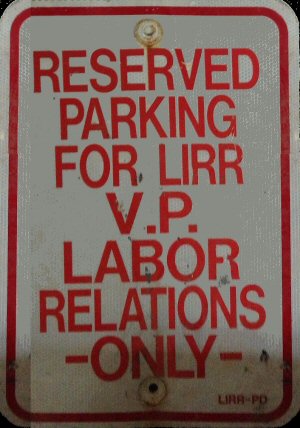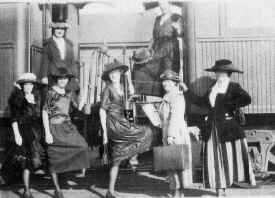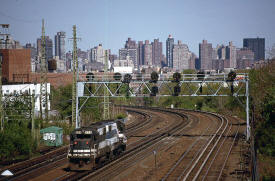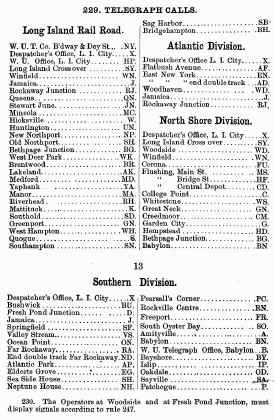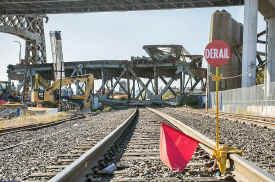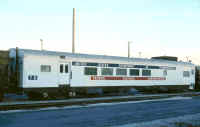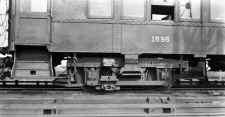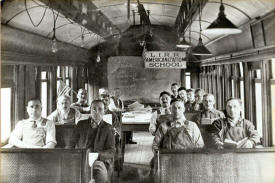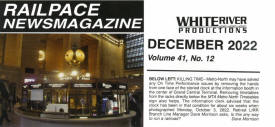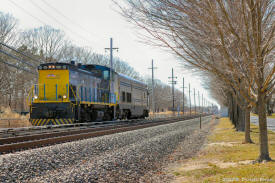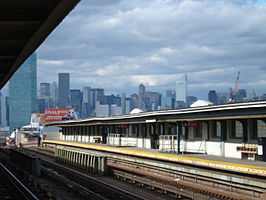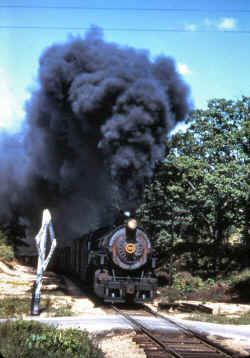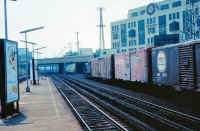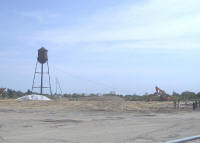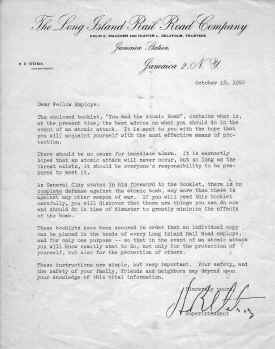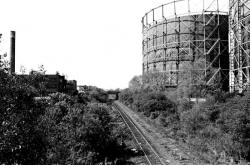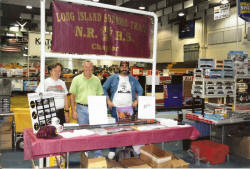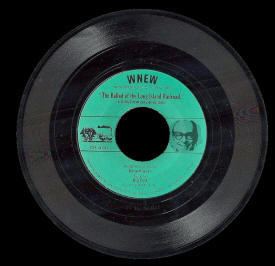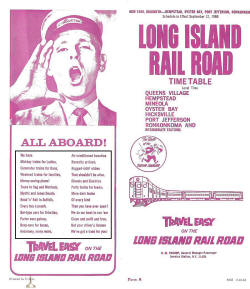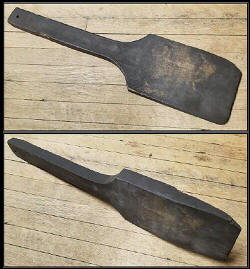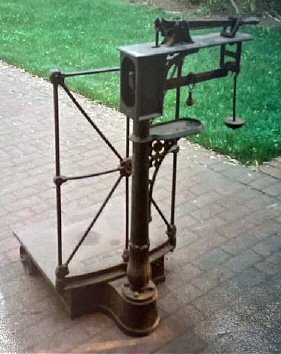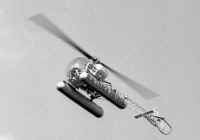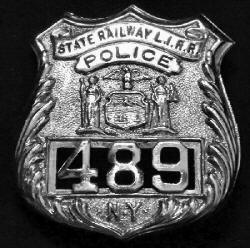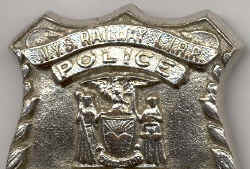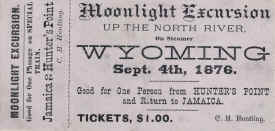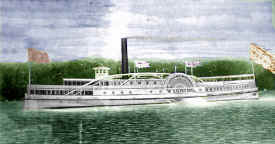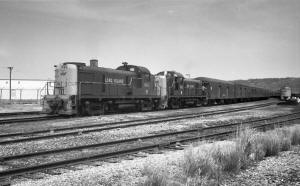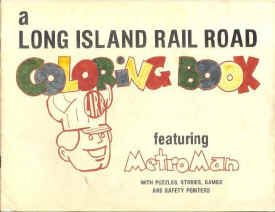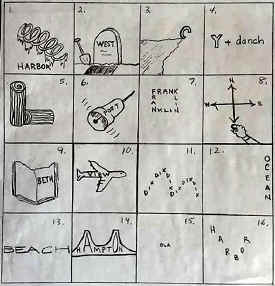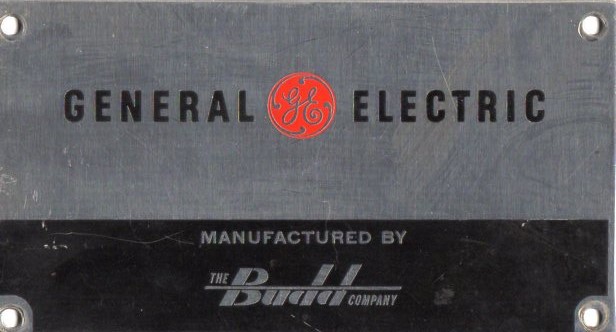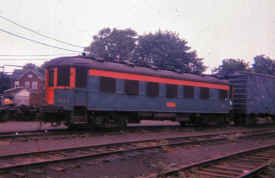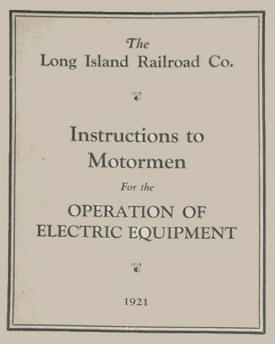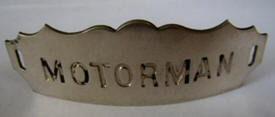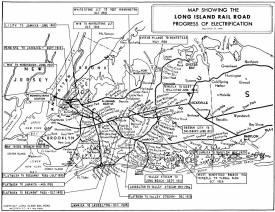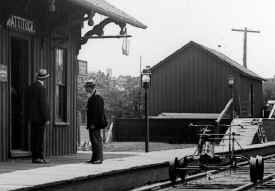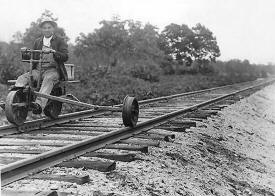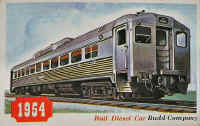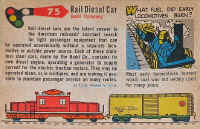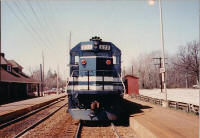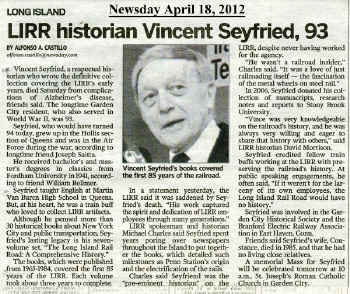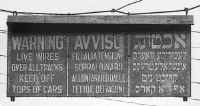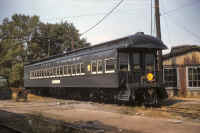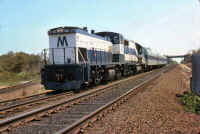|
Long
Island Rail Road - Odds & Ends - Page 1, Page
2 |
|||||||||||||||||||||||
|
The engine has been idling or operating under a light load for an extended period of time or it is cold. Notice how the radiator shutter is closed, indicating low engine water temperature. Diesel engines are most efficient at full horsepower and at hot temperatures. With extended idling/low horsepower usage, the cylinder liners tend to glaze up and unburned fuel and lubricating oil builds up in the exhaust system and as the engine exhaust gets hot from hard work, all this build up burns off and usually clears in a few minutes. I run across this all the time. Info: Paul Kennedy
The hopper car was a former UP car, which was referred to as the "split axle hopper car", and it was instrumented for testing track geometry.
|
What's New "All
Aboard!" Jingle - 1/02/2026
"Kosciuszko Bridge Demolition on the Lower Montauk" At exactly 8am, October 1st, the old Kosciuszko Bridge was imploded in order to speed up the demolition process making way for the second new span. This photo depicts the scene hours after. The implosion left Long Island Rail Road's Lower Montauk blocked for 48 hours while crews worked around the clock to free up the right of way for New York & Atlantic Railway freight traffic.
|
Phantom- Babylon to Brooklyn trains
were cancelled for several days, due to labor issues, one day at a
time and achieved a certain notoriety with it being announced as being
cancelled on NYC radio traffic/commuter reports.
A Change of Engines (CE) in which a DE or DM would have to be swapped out on a passenger set.
Second row
right: LIRR President Frank Aikman
An article was published concerning the use of the "band-aids" in the Long Island Railroader (employee newspaper). When a broken window was discovered from one of the all-to-frequent rock stone throws, this band-aid was applied to crack inside the car.
|
|||||||||||||||||||||
|
|
|||||||||||||||||||||||
| DON MALONE - LIRR PUBLIC RELATIONS | |||||||||||||||||||||||
 Jamaica Station umbrella tag c.1985 This was a program in the mid-80's to lend out the thousands of unclaimed lost and found umbrellas. It lasted perhaps a year, until all the lent umbrellas were stolen or lost. The work of public relations man Don Malone. 50 years ago today, 4/7/1975, I started
in management at the LIRR. Back then, the LIRR's Public Relations
Department had a total staff of six. Our staff photo was distributed
to what was then a long list of daily and weekly newspapers, radio and TV
stations. I wonder what the PR Dept's size is now. I was the
first PR staffer to have a
master's degree in Corporate and Political Communication! |
 |
 LIRR timetable Washington's Birthday 2/19/1973 Design: Don Malone Archive: Dave Morrison |
 LIRR Safety School Book Cover Design: Don Malone - Archive: Mike Kubiak |
||||||||||||||||||||
|
|
|||||||||||||||||||||||
| MINI MAIDS | |||||||||||||||||||||||
 Penn Station LIRR "Mini Maids" c.1968 Photo: Hank Boerner |
The LIRR Mini-Maid program was
alive and well for several years. Women in the employ of the railroad
could volunteer to be fitted with a yellow mini-dress and work at
public affair functions from time to time. Hank Boerner along with
Don
Malone of the Public Affairs department, great enthusiasts of both
trains, women and mini-skirts in general came up with the idea in
1968. Since most women on the railroad at the time were in the
clerical ranks, most of the Mini-Maids were clerks in their 20's. |
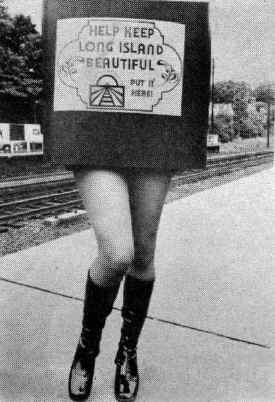 "THAT'S LIRR MINI MAID Jean O'Connell, all dressed up in a replica of one of the the 375 trash cans that have been placed on various platforms and station areas, asking commuters to help keep Long Island clean by depositing their trash in the receptacles as they leave or enter the trains." Long Island Metro Lines issue of September 1973 Archive: Dave Morrison |
|||||||||||||||||||||

When I was a parlor car attendant in
college, Walter McNamara, Special Services Director, assigned me
to a parlor car press trip to Oyster Bay on June 23, 1969. The
trip introduced the LIRR Metro Mini-Maids to the public. A few
days earlier, the LIRR's company photographer composed official
photos of my fellow LIRR employees Marianne Fitzpatrick (left) and
Jessie Wheeler at Bellerose.
Info/Archive: Richard F. Makse |
 |
Newsday’s web feature, “Long Island Then and Now”, found these ladies “flashin’ the (patent) leather” boots in a photo taken by staff photographer Joe Dombroski. The byline says “1969”, so these “Metro Mini Maids” could’ve “inspired” Eugene Garfield to dress – in similar attire – his Auto-Train hostesses, two years later. Info: Edward Frye
MORE: Mini Maids |
|||||||||||||||||||||
|
|
|||||||||||||||||||||||
 Crate, value $150, shipped via REA - label 4/16/1943 Photo/Archive: John Sandrowicz 
|
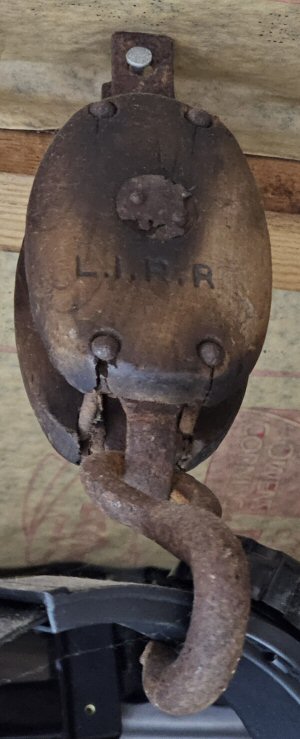 Marine Block & Tackle - Wood case 1880's-1910's Archive: Paul Zimmerman |
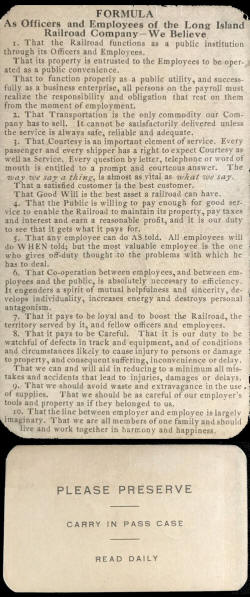 LIRR Formula Card - c.1930 |
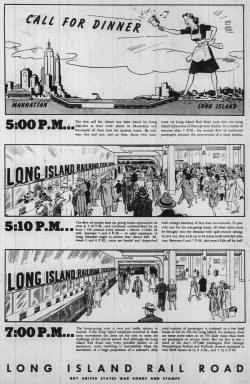 Long Island Rail Road flyer Call For Dinner - c.1943
|
||||||||||||||||||||
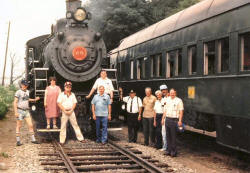 LIST members at the Black River & Western Railroad. They were recipients of an old LIRR/LIST passenger car. Archive: Mike Boland Left to right: Bob Cecere, unidentified female, Jim Gillin, Arthur (Buzzy) Lubitz standing above Bob Southerd (?), unidentified conductor, Bob Sturm, Harold Fagerberg, John J. Scala and Ben Young, longtime LIST President. |
|
 Conductor's Pouch |
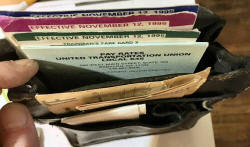 A conductors pouch; the large section is for fare cards, timetables and ticket stock. The small section in front is for seat checks. 11/1995  Engineer tools: Electric brake plug, Reverser key, Brake valve handle |
||||||||||||||||||||
| "All Aboard!" Jingle | |||||||||||||||||||||||
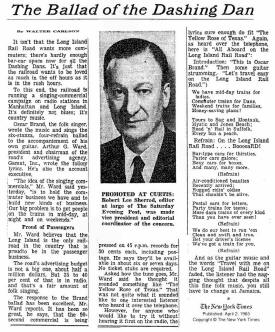 The Ballad of the Dashing Dan - 4/02/1965 NY Times |
|
"The Ballad of the Long Island Railroad"
From
the point out there at Montauk as it whimpers into town It's the old Long Island Railroad you can hear it breaking down
|
|
||||||||||||||||||||
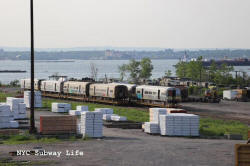 Some Budd M1, M3 & M7 Already Loaded on Flat Cars, at the 65th St Rail Yard, Bay Ridge for their trip to Ohio for scrapping... Thank You For Your Service! Photos/Archive: NYC Subway Life 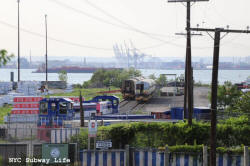
|
 Sarnelli Bros. scrapping, Coney Island 1956 Photo/Archive: John Scala A pile of MP54’s, B54’s, and some MP41’s from the early 1950’s. IRT low-V subway cars scrapped along side LIRR MP54's.  LIRR Conductor Badge/Hat 1971 worn with MTA blue uniform. Photo/Archive: John Smolczynski More of Dave Keller's Cap Badge Evolution History
After standardization the S was reduced to be used as a temporary speed limit sign.
W/S post is combined Whistle Post and View S across Mill Dam Creek, East Rockaway c.1920 Archive: Ed Gloeggler |
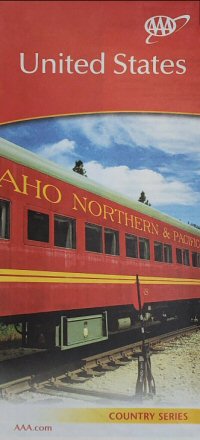
|
AAA United States map (2012 edition) with a MP72/P72 on the front cover. This may be the first appearance of anything LIRR related on a nationally published map, yet alone a highway route map of the entire United States with parts of Canada! Photo is of the Idaho Northern & Pacific in Horseshoe Bend, ID. Jeff Erlitz's notes: Six cars ended up at Idaho Northern & Pacific: MP72Ts 2003, 2014 (PP72B class) and P72s 2931, 2941, 2953, 2969. Photo credit is David
R. Frazier of Delimont Stock Photography. Archive: Kevin Wong
|
||||||||||||||||||||
|
|
|||||||||||||||||||||||
| LIRR POLICE - HELICOPTERS - SHIELDS - PATCHES - HAT BADGES | |||||||||||||||||||||||
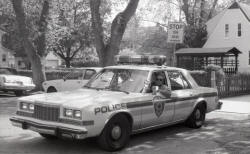 |
Long Island Rail Road police officer Stan Hansen
in the second shift Mineola sector car known as RMP 58, radio motor
patrol car 58 seen in Mineola in the Spring of 1983. Photo/Archive: John Krattinger |
 Rockville Centre, LIRR police car view NE 12/25/1976 (Madden-Keller) |
|||||||||||||||||||||
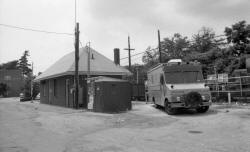 |
The Long Island Rail Road Police Department mobile command center deployed to the parking lot adjacent to the Little Neck Station on the Port Washington Branch. It was undoubtedly needed due to the extremely frenetic scene. OK, so it was actually a ghost town due to to an extended service disruption that lasted nearly a week on the Port Washington Branch, but this will be key to our story Photo/Archive: John Krattinger |
||||||||||||||||||||||
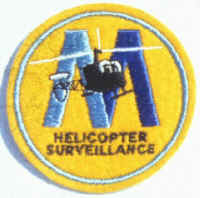 MTA helicopter surveillance patch c.1970 Archive: Art Huneke
|
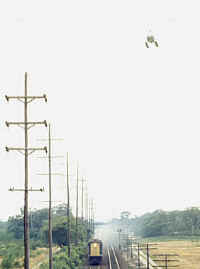 Helicopter patrol c.1970 Archive: Art Huneke
|
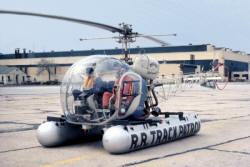 LIRR Police Track Patrol Helicopter Bell 47 c.1970 Archive: Art Huneke
|
 Long Island Metro Lines "Big eye in the sky" April 1971 Archive: Al Castelli 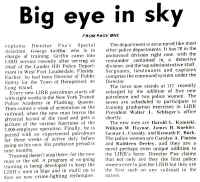 |
||||||||||||||||||||
 Vintage Police Service #160 L.I.R.R. Co. Star Badge Info: Dave Keller |
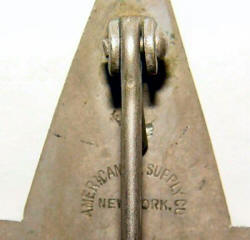 Back of badge showing provenance from "American Ry Supply, NY” c. 1880's- 1890's (?). Info: Dave Keller |
||||||||||||||||||||||
|
|
The LIRR had a problem with their shields
throughout the years. Some were handed down from Father to Son, and
therefore are of the older style. This style is known as "The
Acorn" due to its shape. This shield was still in use in the
early 1980's and was in the desk of my friend that dealt with uniform
issues. The balance of the shields had top ribbons that stated
anything from "RAILROAD", "STATE RAILWAY", "N.Y.S.
RAILWAY", "N.Y.S. RAILWAY L.I.R.R" all incised into the
shield.
Research/Photos/Archive: Yardgoat398 unless noted. |
||||||||||||||||||||||
|
|
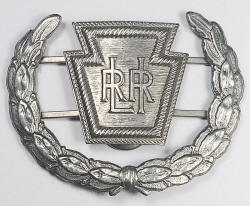 LIRR Police Department Hat Badge c.1933 Usage: 1929 to ~1946 |
|
|||||||||||||||||||||
|
In the mid to late 1970's the LIRR ran short of Patrolman's shields and sought shields from other New York State Agencies to use with an applied top "Custom made Ribbon" with raised letters stating "N.Y.S. RAILWAY L.I.R.R." and is known as the "Applied Ribbon" style. Not many of these were made and are considered hard to come by. A shield issued in the 1960's could have survived well into the time period that the LIRR standardized their Patrolman, Detective, and Sergeant shields. Within a group it was rarer to get two shields that were alike than different. Some members never moved up the LIRR PD ladder and had the same shield that was issued to them 30 years ago.
This example of a "1970's Applied Ribbon" is on another agencies shield. The other agencies name has been ground down to accommodate the application of the "Custom Ribbon".
|
|||||||||||||||||||||||
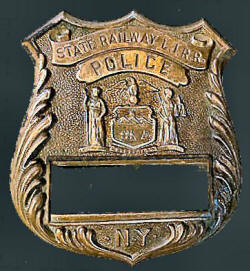 |
These are standard stock "New
York" style badges. The department lettering is "incised"
lettering pressed into the badge, (any Department could be pressed
into the ribbons and filled with what was known as "soft" enamel). |
||||||||||||||||||||||
|
In the late 80's/early 90's the department standardized the Patrolman and Sergeant shields with the top ribbon very similar to the
"Applied Ribbon" lettering used on the late 70's Patrolman shield. This new shield known as the
"Custom Die" shield was
issued in the late 80's and mostly early 90's, ironically, just prior to the consolidation of the LIRR, MNCR, and later the SIRT (Staten Island) Departments under the flag of the MTA. All new shields, collar devices, and patches were created and issued.
This example is the last shield of the LIRR under their original charter (LIRR not MTA) and is a complete "Custom Die" and is a one piece shield hallmarked by United Insignia. This is the 1990's shield. |
|||||||||||||||||||||||
 LIRR Police patch used in the 1970's worn only on one sleeve. They would have switched to the MTA LIRR Police patch some time before 1989/1990. |
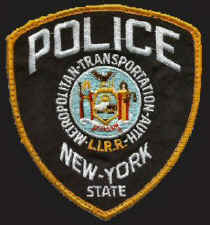 LIRR-MTA 1980's New York State patch, placed on both sleeves, in use until c.1998 when the police departments (LIRR & Metro North) were merged. |
||||||||||||||||||||||
-1943_Huneke_small1.jpg) LIRR Women Trainmen "Wheels" Uniforms 1943 Photo/Archive: Art Huneke |
-hat-1943_Huneke.jpg) LIRR Women "Trainman " hat 1943 Photo/Archive: Art Huneke |
 LIRR Trainman armband c. WW II era |
|||||||||||||||||||||
|
I surmise this LIRR Trainman armband was probably from the WWII era when men were away at war and women filled in their positions. While the remaining men who weren't called for active military service still had their uniforms and cap badges from before the war began, new uniforming of hundreds of these women when military uniforming took precedence perhaps led to a temporary unavailability of uniform caps with the woven-weaved "Trainman" position later seen in various images of women train crews at work during this time period. (Dave Keller info). |
|||||||||||||||||||||||
|
|
|||||||||||||||||||||||
 LIRR valuation map 1919 Wading River Extension zoom "F" sign symbol indication |
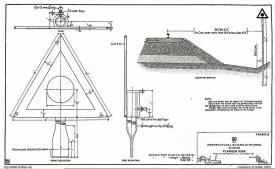 PRR Flanger Sign 10/1924 Archive: Walter Staffa The "F" map symbol indicates the need for flanger/plows to be raised at road crossings .  LIRR Ticket Vending Machine Lock-Box Nostrand Ave 12/27/13 Photo: Ron Yee |
|
|||||||||||||||||||||
|
Note: REX” Trains = Trains consisting of all REA and/or baggage cars. According to the late retired engineer Herb Doescher (via Robert Sturm), the REX trains were the fastest under steam on the road. The lack of scheduled station stops saw speeds in excess of 100mph not unusual. The men clocked the number of telegraph poles passed per minute to determine their speed. Dave Keller
|
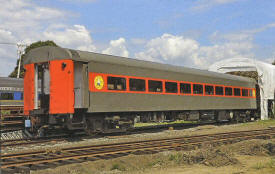 LIRR P72 #2943 Newport & Narragansett Bay Railroad Co. 7/05/2020 Archive: Andrew Grahl  Newport Dinner Train - Railpace Magazine 10/2020 Info: Andrew Grahl |
|
|||||||||||||||||||||
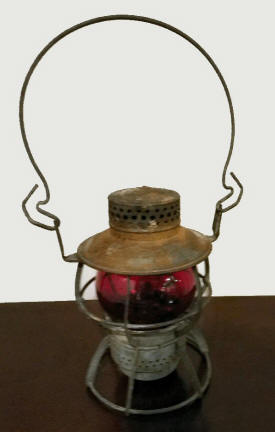 LIRR Conductor hand lantern and they generally carried two, one with a red globe and one with a "white" or clear globe. The globe, when taken out of the lantern frame, is approximately 3 1/4" high and thus this type of lantern is called a "short" globe lantern. Vintage is 1920's manufactured by Dressel Lamp Works, Arlington, NJ. Info: Robert Myers |
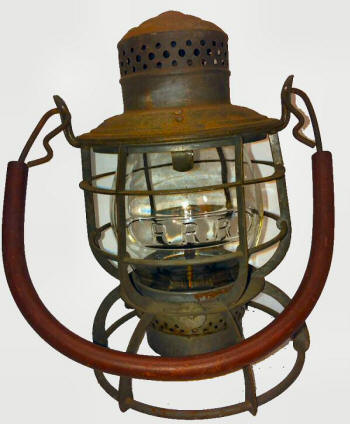
 Armspear PRR style clear globe lantern 1889 with LIRR markings |
 LIRR Lantern PRR-LIRR Lantern c. 1925 |
|||||||||||||||||||||
 "Our Butch" 1939-1948 North Shore Historical Museum Photos: Dave Morrison 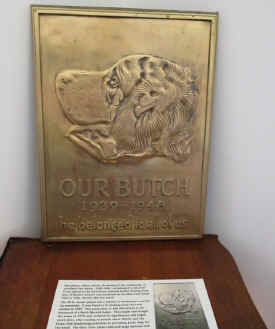
|
 Win-A-Trip - NEWSDAY Ad 1998 |
 Friday, December 6, 2019 Towns move to ditch $1 South Fork Commuter Connection shuttle fare The Towns of Southampton and East Hampton are moving to eliminate the $1 fare for the South Fork Commuter Connection shuttle buses, making the connecting shuttles free to use with a LIRR ticket. Info: LIRR December 6, 2019 News came from Assemblyman Fred Thiele's office last week that the News came from Assemblyman Fred Thiele's office last week that the LIRR has agreed to restore the South Fork Commuter Connection service between Speonk and Montauk this fall. August 5, 2021 at Southampton, Bridgehampton, East Hampton, and Amagansett.
|
|||||||||||||||||||||
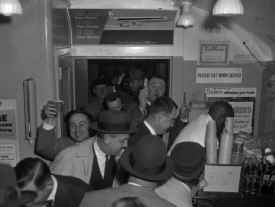 LIRR bar car #120 previously Class P54D #5769 c.1961 (John Duprey - NY Daily News)
|
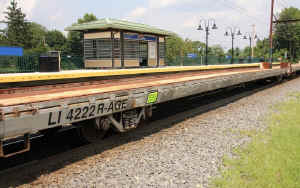 LI #4222 flat at Yardley, PA 8/07/18 Photo: Tim Darnell LI #4222 "R-AGE" with the sticker "Home shop for repair, do not load". The LIRR just purchased these former RBBX flatcars from Ringling Bros. and were in transit from Palmetto, FL to Fresh Pond. They attempted to acquire them when the circus train was in town to avoid the shipping costs but, couldn't finalize the details in time. "Home shop for repair" refers to AAR rule 88, which allows a defective car, on
another railroad, to be moved to the home shop for repair, rather than having the railroad where the car sits now repair it and bill the owning RR. LIRR purchased eight ex-Ringling Bros. Circus train flats (LI 4215-4222). Arrived on 8/09/18 and appears three are in use currently for the Harold Interlocking project. (8/25/18). Info: Gregory Grice |
 Bethpage Station Ticket Vending Machine 10/03/2017
|
|||||||||||||||||||||
 "A Wedding on Wheels" October 1993 issue of "Along The Track" Archive: Dave Morrison |
Oct 1993 issue of "Along The Track", an official LIRR publication that reported that the 1993 wedding on board a Montauk train "was the first held on an LIRR train." The LIRR Public Affairs Department forgot all about the July 9, 1977 wedding that took place on a Greenport train. That forgetfulness is probably easy to understand, however.. No one of importance was on that train , except the General Chairman of the United Transportation Union, Ray Mills who married Carol Wagnor on the train. Additionally, the MTA Board Chairman, Harold Fisher, and the LIRR President, Robert Pattison, were also on the train. People easy to forget! I was on the train, also. The track east of Riverhead was so poor during that period, the train speed was 30 mph. When the ceremony took place while the train was moving, the engineer was ordered to slow it down to 15mph or less. AND, the car was still bouncing around. A trainmaster in the car, got on his radio and ordered the engineer to stop the train. When at a stop, the minister performed the brief ceremony and the train got back underway. Info: Dave Morrison |
||||||||||||||||||||||
|
|
This is a builder's plaque from the cab door of one of the M1 cars from the 1972 add-on order
of 150 cars (9621-9770) which were built by a consortium of Budd and GE.
The earlier M1 plaques read "Designed and Built by the Budd Company" with their logo name.
Info: Mike McEnaney |
||||||||||||||||||||||
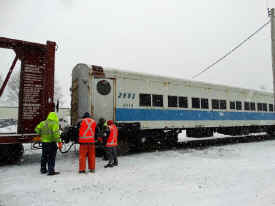 Photo members of the RMLI confer with the New York and Atlantic Railway crew on Saturday, January 7, 2017 as the certified air brake system on ex-LIRR, ASR Bar Car #2993 is fully charged. |
On Saturday, January 7, 2017, LIRR Bar Car #2993 began its journey to the Adirondack Scenic Railroad (ASR) in Utica, NY. The car, (not owned by the RMLI), was donated to the ASR by its owner for use as a Bar/Concession Car. RMLI's Founding President, Mr. Chris Talluto is the ASR's Chief Mechanical Officer. Chris spent a good part of summer 2016 performing maintenance and certification work on the car. The Museum assisted Chris with helpful manpower and the use of our backshop for various work details. The Railroad Museum of Long Island celebrates and supports ASR's acquisition of #2993. Not only will this LIRR car be saved, it will be used in revenue service for the purpose the LIRR originally modified it for, saving another piece of Long Island heritage!! Thank you for video taken by Jordan Torregrosa, member of the RMLI "Steam up LIRR 39" committee. There were on four 2900 series Bar Cars 2990-2993 Yes, the routing was New York & Atlantic (Riverhead to Fresh Pond) to CSX (Fresh Pond to Oak Point to Selkirk and then on to Utica). There was never a discussion about having a rider in the car. We overhauled the brake system to current standards, did the COTS and repaired the rusting stairwells as "safety appliances" and sent her packing :-) |
||||||||||||||||||||||
|
|
Chicago North
Shore & Milwaukee 411 Built
in:1923 by Cincinnati Car Company, Out-of-service/Retired:1963,
Type of car: Interurban (coach, converted
tavern/lounge) |
||||||||||||||||||||||
 ASC Test Loop at the west end the Babylon platform - Photo/Archive: Joe Gregory |
Automatic Speed Control test loop. On a regular basis, each lead car must have its speed control system tested. That box contains a switch which activates an oscillator to permit this. The Automatic Speed Control System was introduced after the horrific wrecks in 1950. It includes simplified cab signals and an arrangement which applies the brakes if the train passes a more restrictive signal without the engineer taking action. |
||||||||||||||||||||||
 Comic Con 2013 LIRR flyer
|

 Commuter leaping into LIRR #9350 cab at Penn Station 2/12/1983 Photo: Newsday Archive: Kenneth F. Lemp |
 PRR N5 #477604 caboose Hempstead 4/05/1934 (Votava-Keller)
|
|||||||||||||||||||||
 GO 704 Track Barricade Sign 3/02/2022 |
 Speno International rail grinding train C-64 caboose - Hewlett 10/1979 Photo/Archive: Art Huneke |
 LIRR conductor E. Deirdre Hickey waves from the cab of her train on June 6, 1979. Dee Hickey was the First Female Qualified Conductor of the modern era. She joined the LIRR in 1973 and worked her first day as a conductor Info: "Along The Track" LIRR |
|||||||||||||||||||||
|
|
|||||||||||||||||||||||
| LIRR MOTORMEN | |||||||||||||||||||||||
|
|
|
|
|
||||||||||||||||||||
|
|
|||||||||||||||||||||||
| LIRR VELOCIPEDES | |||||||||||||||||||||||
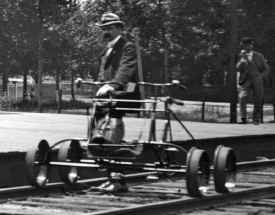 Riverhead Station View SW c.1905 velocipede Zoom Photo: LIRR Chief Engineer Archive: Dave Keller
Note: The correct name of these vehicles are
velocipede as speeders are self-propelled with some form of fuel-driven
engine. |
|
The LIRR often used
velocipedes by photographers, one important occasion was the documentation
of all property owned by the railroad. |
|||||||||||||||||||||
|
|
|||||||||||||||||||||||
| LONG ISLAND RAILROAD RESTAURANTS | |||||||||||||||||||||||
 Red Caboose restaurant ex-LIRR C93, ex-IC #9847 acquired: 1/72 - Westbury c.1975 Photo/Archive: Tim Darnell |
|
 Station Road restaurant - View NE 9/28/1987 Photo/Archive: Edward Hand Logo reads: "TCC TS" intertwined for "The Club Car /The Station." |
 Spice of Life restaurant Woodmere ex-NYC 1910 caboose 8/01/1976 Photo/Archive: Tim Darnell |
||||||||||||||||||||
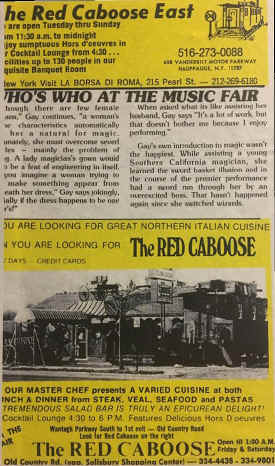
|
 Red Caboose Restaurant matchbook 640 Old Country Rd., Westbury Photo/Archive: John Stine |
 "The Dining Car 1890" now Curry Club Restaurant. Ex-SLSF Kansas originally #2500 2/17/2017 Photo/Archive: Philip Marshall 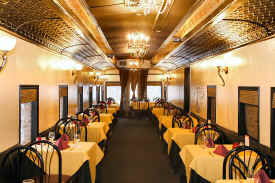 Curry Club interior; ex-The Dining Car 1890 located in Setauket at the corner of Nichols Road and 25A. The original restaurant and related buildings are still standing, pretty much in tact. The Dining Car closed around 1992 for financial reasons, and was vacant for a few years before it reopened as the Curry Club. |
TAJ Crown of India - 4/23/2025 originally "The Dining Car 1890" ex-Curry Club Photo/Archive: Edward Hand |
||||||||||||||||||||
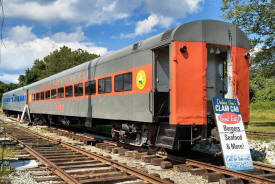 Dashing Dan's Clam Car #2943 Portsmouth, RI 8/02/2021 |
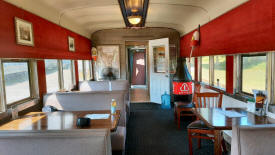 #2943, a P72 class coach original LIRR number, was sold to the Newport & Narragansett Bay Railroad Co. which owns the clam bar. |
 |
 Little Gull Cafe - ex-Speonk Station view NE 1/19/2022 - Photos/Archive: Dave Morrison |
||||||||||||||||||||
|
|
|||||||||||||||||||||||
| Grade Crossing Crash (delineator) Posts | |||||||||||||||||||||||
 LIRR Grade Crossing Crash Posts - Willis Ave, Mineola 5/15/18 Newsday - Photo: /Howard Schnapp
|
They’re called delineators. They’re flexible/breakaway and will not physically prevent a vehicle from entering the track area. They exist only to inform motorist that the lane continues over the grade crossing; it’s an effort to prevent drivers from turning onto the tracks. |
||||||||||||||||||||||
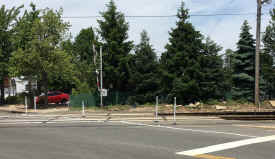
|
|
 Riverhead, Sweezy Ave 9/13/2018 Photo/Archive: Steve Rothaug |
|||||||||||||||||||||
|
|
|||||||||||||||||||||||
| LONG ISLAND Railroader magazine - August, 1955 1st Employee Outing 1/18/2018 | |||||||||||||||||||||||
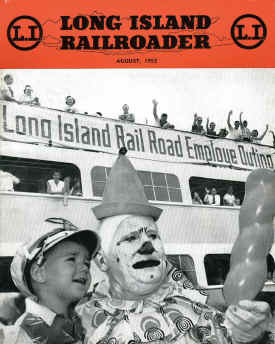 LI Railroader magazine cover August, 1955 1st Employe Outing |
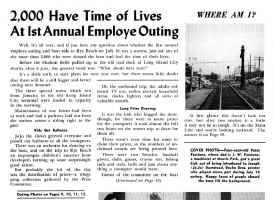 LI Railroader - Employe Outing - 8/1955 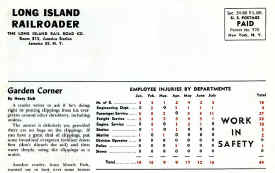 LI Railroader - Back page "Employee" injuries by Departments Jan-July 1955 Archive: Dave Morrison |
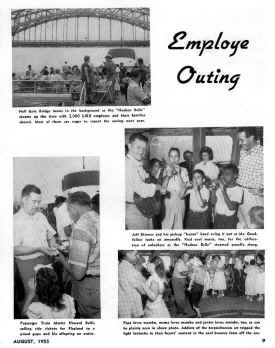 LI Railroader - Employe Outing Page 9 - 8/1955 |
|||||||||||||||||||||
|
|
|||||||||||||||||||||||
| LIRR - US OPEN GOLF - June 12-15, 1986 | |||||||||||||||||||||||
 Southampton College - US Open View NW 6/1986 Photo/Archive: Art Huneke |
 Southampton College - US Open View SW 6/1986 Photo/Archive: Art Huneke |
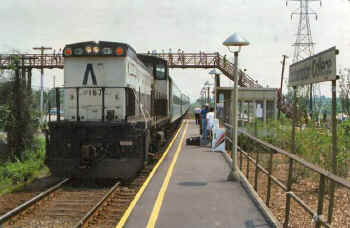 Southampton College - US Open LIRR # 167 View E 6/1986 Photo/Archive: Art Huneke |
|||||||||||||||||||||
%20-%2006-12-86_Huneke-Keller_small.jpg) |
GP38-2 #272 with special eastbound train makes the stop at Southampton College station at the Tuckahoe Rd. crossing for the 1986 U.S. Open held at the adjacent Shinnecock Hills Golf Club. A temporary wooden footbridge has been constructed to allow the large crowds to safely cross over the tracks and busy Route 27 (County Rd. 39) as seen in this westward view on June 12, 1986. This was the former site of the old Golf Grounds station. (Art Huneke photo, Dave Keller archive) |
%20-%2006-12-86%20(Huneke-Keller)%20(Zoom)_small.jpg) |
|||||||||||||||||||||
|
|
|||||||||||||||||||||||
| LIRR - US OPEN GOLF - June 14-20, 2004 | |||||||||||||||||||||||
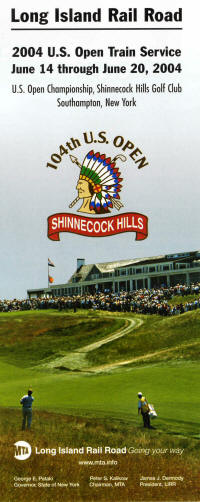 |
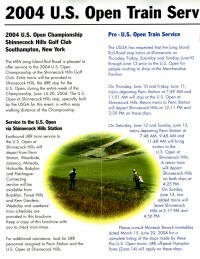
LIRR Timetable Shinnecock Hills US Open 6/14/2004 to 6/20/2004 Archive: Dave Keller
|
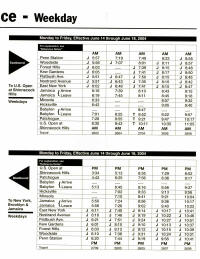 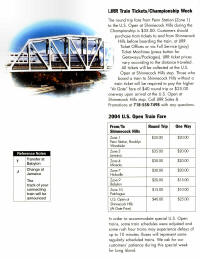 |
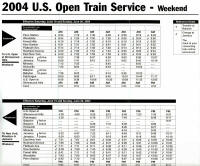 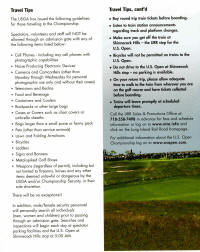 |
||||||||||||||||||||
|
|
|||||||||||||||||||||||
| LIRR - US OPEN GOLF - June 15-21, 2009 | |||||||||||||||||||||||
|
SOUTHAMPTON
|
|||||||||||||||||||||||
 LIRR Timetable US Open 06/15/2009 Archive: Al Castelli |
LIRR Kiosk side view Bethpage State Park US Open 2009 05/25/09 Photo: Al Castelli |
LIRR Kiosk with 175th anniversary flags. Front view Bethpage State Park US Open 2009 5/25/09 Photo/Archive: Al Castelli |
|||||||||||||||||||||
|
|
|||||||||||||||||||||||
| LIRR - 118th US OPEN GOLF - June 7-17, 2018 | |||||||||||||||||||||||
 Shinnecock Hills U.S. Open LIRR timetable cover June 7-17, 2018 |
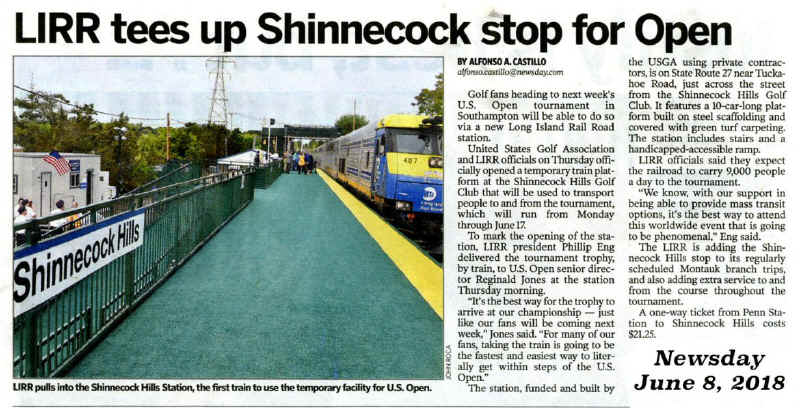 Shinnecock Hills ready for the June 7-17, 2018 U.S. Open |
||||||||||||||||||||||
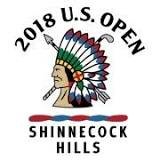
|
 118th US Open - Shinnecock Hills - View E 6/16/18 Photo/Archive: Richard Althaus |
||||||||||||||||||||||
|
|
|||||||||||||||||||||||
| LIRR - 101st PGA CHAMPIONSHIP - May 13-19, 2019 | |||||||||||||||||||||||
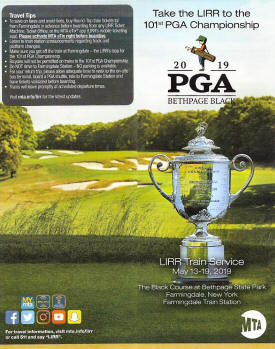 LIRR 101st PGA Championship - May 13-19, 2019 Bethpage, NY Archive: Warren Leunig |
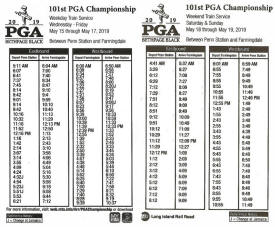 101st PGA LIRR schedule Penn to Farmingdale - May 15-19, 2019 Archive: Warren Leunig |
 Tickets Ronkonkoma to Farmingdale 5/19/2019 Archive: Warren Leunig 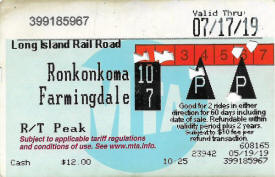 |
|||||||||||||||||||||
|
|
|||||||||||||||||||||||
| LIRR - RYDER CUP - September 23-28, 2025 | |||||||||||||||||||||||
 LIRR Ryder Cup - September 23-28, 2025 Bethpage, NY |
The LIRR has made available a
special Ryder Cup Bethpage State Park Black Course ticket that is valid system-wide (ALL Zones 1 to 14)
for eight days (Monday September 22 to Monday September 29, 2025) for
the Tournament... Price: $175 available from Stations and TVMs as a
standard ticket. The Ronkonkoma Branch and
Farmingdale Station are going to be very busy during Ryder Cup week |
||||||||||||||||||||||
|
|
|||||||||||||||||||||||
|
BNSF will bring 16 rail cars onto the island and park them on the Central Branch in Uniondale for the duration of the Ryder Cup and use the area as a staging facility for bus passenger access for tournament guests headed to the Ryder Cup, Bethpage. BNSF will pay LIRR $3,112 a day for eight days ($1,128 for land use and $124 each car per day). |
|||||||||||||||||||||||
|
|
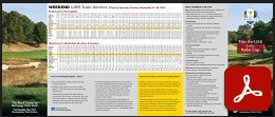 Ryder Cup Brochure/Schedule 9/2025
|
 BNSF OCS train at the Central Branch Uniondale siding - 9262025 View E Photo/Archive: John Krattinger
|
|||||||||||||||||||||
|
BNSF 50 MT. HELENA
BNSF 6 TOPEKA |
|||||||||||||||||||||||
 BNSF OCS train passing Elmont the morning of 9/22/2025 Photo/Archive: Thomas Farmer |
 BNSF OCS consist passing Elmont the morning of 9/22/2025 Photo/Archive: Thomas Farmer |
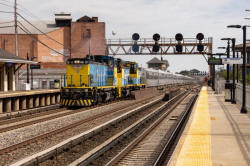 BNSF OCS train passing Hempstead 9/22/2025 Photo/Archive: Thomas Farmer |
 BNSF OCS consist passing Garden City 9/22/2025 - Photo/Archive: Thomas Farmer |
||||||||||||||||||||
|
After a week-long adventure involving a trip down the Hudson, followed by a reroute over the B&A and NEC, the BNSF OCS (Office Car Special) finally arrives on Long Island the morning of September 22nd, 2025. LIRR MP15ACs #158/167/163 hauled 14 OCS cars over the final leg of the journey from Fresh Pond to Garden City, with the #150 following as a chase engine. The train arrived at Garden Mitchell Secondary just before 12:30 PM, a roughly 2-hour journey from Fresh Pond. (9/22/2025) The consist was parked east of the fire department next to the commercial buildings. Thomas Farmer |
|||||||||||||||||||||||
 |
 |
 |
|||||||||||||||||||||
|
BNSF OCS train on the LIRR passing the Nassau
Boulevard train station located in the village of Garden City, coming
back from the Garden Mitchell Field Secondary after sitting there for
a week for the Ryder cup golf tournament in Bethpage. View E -
9/29/2025 Photo/Archive: Nicco Esposito |
BNSF OCS at Forest Park returning home with LIRR
MP15ACs #167 chase engine 9/29/2025 - Photos/Archive: Thomas Farmer Note: The "chase engine" is checking for 3rd rail damage. The OCS car's outside swing hanger bars on the trucks comes perilously close to 3rd rail cover boards. Chris Glöck |
||||||||||||||||||||||
|
|
|||||||||||||||||||||||
| 1862 TIMETABLE - LI CITY TO GREENPORT | |||||||||||||||||||||||
|
|
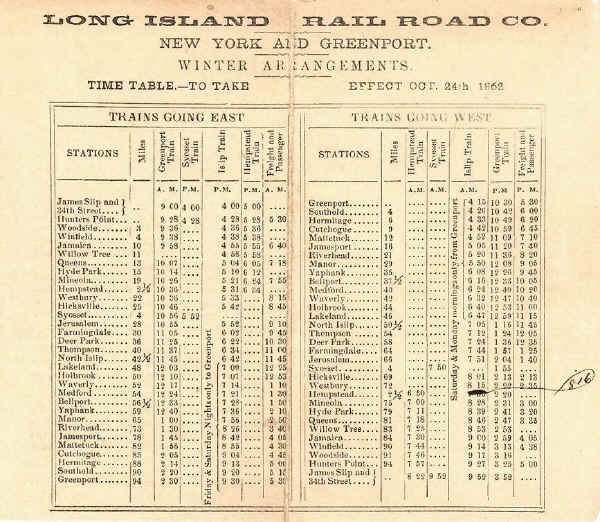 Public timetable LI City, (Hunters Point), to Greenport 10/24/1862 |
||||||||||||||||||||||
| PORT JEFFERSON BRANCH NAMED CALL LETTERS - 10/07/61 - 10/03/77 | |||||||||||||||||||||||
 LIRR Railroader - Renamed interlockings 10/11/1961 Archive: Dave Morrison
|

|
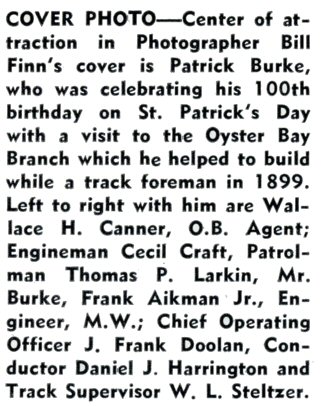
|
|||||||||||||||||||||
|
Prior to being simplified, the interlockings of the Port Jefferson Branch for a period in the mid-20th century were changed as follows: |
LIRR Railroader - Retired Conductor
Patrick Burke 100th Birthday, April, 1954 Archive: Dave Morrison |
||||||||||||||||||||||
|
Amott: Retired Engineers Joseph
H., JR., Charles A. and James A. Amott In service: 10/07/61 - |
|||||||||||||||||||||||
| METRO-NORTH SPV2000 #291 RAIL DIESEL CAR- VIDEOTAPING ROW MARCH 3, 1986 Archive: Art Huneke | |||||||||||||||||||||||
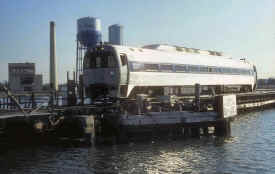 Metro-North SPV2000 #291 Rail Diesel Car at Wreck Lead |
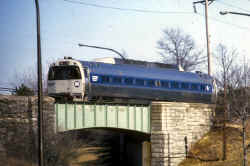 Metro-North SPV2000 #291 Central Branch, Southern State Pkwy, West Babylon exit |
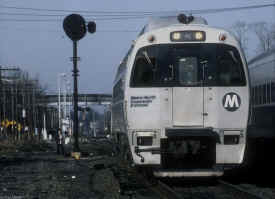 Metro-North SPV2000 #291 Rail Diesel Car at "KO" Ronkonkoma |
 Metro-North SPV2000 #291 Rail Diesel Car at "KO" Ronkonkoma |
||||||||||||||||||||
| DELEVAN HOUSE at BROAD CHANNEL | |||||||||||||||||||||||
 A rare and very old LIRR valuation photo of the Broad Channel station and station area looking south from the pedestrian crossover (bridge) on August 3, 1914. The ticket office and waiting room appear to be housed in the first floor of the Delevan House at the left as evidenced by the bay window and scattered chairs. (LIRR valuation photo, Dave Keller archive and data) |
Delevan House (see left photo) advertising aluminum encased "Good Luck Cent" | ||||||||||||||||||||||

|

|
||||||||||||||||||||||
|
These
places at Broad Channel, Goose Creek and The Raunt were strictly
saloons and inns. The sign on the rear left building may read
"Palm Garden" and was either the restaurant portion of the
saloon, or a Bier Garten. The buildings are separate from each other,
so may be two different business concerns. The signs posted by the
pedestrian stairs in front of the "Palm Garden" and on the
opposite side of the tracks at platform's edge read: "No
Trespassing. No Crossing Tracks. Use the Bridge." The
rowboats were for rent, as this was basically a fishing stop. Info:
Dave Keller |
"Keep Me And Never Go Broke" slogan on horseshoe. Aluminum encased 1909 Indian Head Cent (obverse) "Good Luck Cent" |
"Delevan House - E.H. Schlueter" 1909 Indian Head Cent (reverse) |
|||||||||||||||||||||
|
|
|||||||||||||||||||||||
| LIRR CERAMIC TILES | |||||||||||||||||||||||
 Farmingdale LIRR 150th Anniversary 1841-1991 artwork/ceramic tile  |
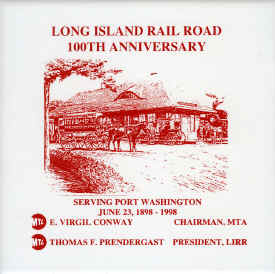 Port Washington LIRR 100th Anniversary 1898-1998 artwork/ceramic tile 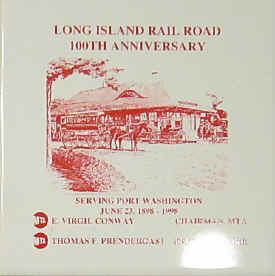
|
 Sea Cliff LIRR 100th Anniversary 1888-1988 J. Montelione artwork/ceramic tile  |
|||||||||||||||||||||
 St. James artwork - Vincent Quatroche - Oldest surviving LIRR built station 1873-Present Day (restoration 1997) |

|
Photos/Archive this section: Dave Morrison |
|||||||||||||||||||||
|
Affixed to a rider’s luggage in the old days. The express agent would put it on the bags with a leather strap. Upon receipt of your bag(s) at your destination, the express agent would remove the tag for reuse for another customer on another train. American Railway Supply Co., was in business from 1891 to the 1920s. Info: Brendan Manley |
|||||||||||||||||||||||
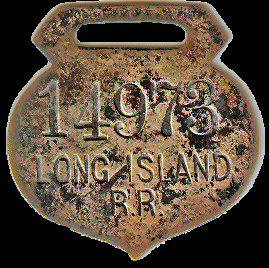 Brass Baggage Tag Collection: John Fusto |
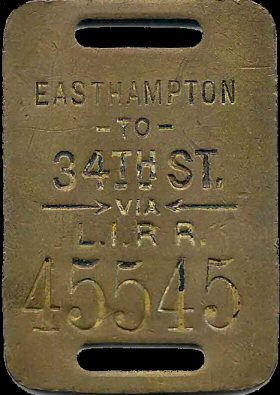 Penn Station to Easthampton baggage tag #45545 Archive: Carol Mills |
 Brass Baggage Tag Collection: Brendan Manley |
|||||||||||||||||||||
 Penn Station to Garden City Baggage Tag Collection: Brendan Manley |
 LIRR baggage tag #18240 Archive: Carol Mills |
 Baggage Tag South Side Rail Road of Long Island |
|||||||||||||||||||||
 Brass Baggage Tag Flatbush Ave. to Great River 01/2008 Collection: Brendan Manley |
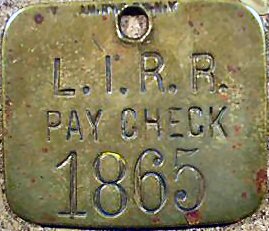 LIRR Brass Pay Check Tag To the best of my knowledge, it was used to pay employees out on the line (perhaps as a "chit" to be cashed in somewhere where cash was available)...maybe a a major station where the ticket agent had copious amount of the green stuff and could pay you out of his "cash drawer" from selling tickets, etc, or maybe a major terminal like Jamaica, where cash was disbursed to outlying terminals for different purposes. Info: Robert Myers |
 Penn Station to Easthampton baggage tag #45649 Archive: Carol Mills |
|||||||||||||||||||||
 Ronkonkoma to 34th St. and reverse side #22673 Brass Baggage Tag Collection: Brendan Manley |
 Baggage Tags c.1962-1963 Archive: Art Single |
||||||||||||||||||||||
| LIRR Playing Cards | |||||||||||||||||||||||
 Sunrise Trail playing cards c.1921 Archive: Carol Mills |
 Sunrise Special playing cards c.1921
|

 LIRR 160th Anniversary playing cards 1994 Archive: Joe Saullo |
|||||||||||||||||||||
| TOPPS "RAILS AND SAILS" 1955 CARDS | |||||||||||||||||||||||
 1955 Topps "Rails and Sails" no.34. LIRR #193 Rotary Plow |
 1955 Topps "Rails and Sails" no.34 reverse |
Topps bubble gum card set 1955 “Rails and Sails”. The set has two parts, the first 130 cards being about trains, and the second 70 cards being about ships. The backs for each set are all done with color, an unusual quality for trading cards. The backs also are among the most genuinely informative ever done. $10-$125 condition (VG-EX-4 Mint 9 condition) according to a price guide. | |||||||||||||||||||||
| GOVERNMENT TRANSPORTATION REQUEST | |||||||||||||||||||||||
 Ticket Form LH-261-G US Government Archive: Brad Phillips |
A transportation request ("TR") was issued to members of the military and employees of all branches of the Federal Government in lieu of cash to purchase passage by any means (rail, bus, air, etc.). Tickets issued were endorsed "United States Government" to prevent the traveler from turning them in for a cash refund if not used. LIRR stations having a large volume of government business had tickets pre-printed with the endorsement. More recently, credit cards ("travel cards") have become the preferred means for government travelers to pay for their traveling expenses (including hotels, meals, etc.). |
 Form Government Transportation Request Archive: Brad Phillips |
|||||||||||||||||||||
| REV. PAUL CUFFEE, INDIAN PREACHER | |||||||||||||||||||||||
 Rev. Paul Cuffee Gravesite March 4, 1757 - March 7, 1812 |
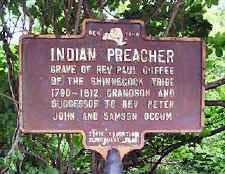 Rev. Paul Cuffee historical maker |
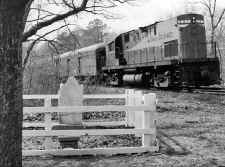 LIRR #207 eastbound Hampton Bays Rev. Paul Cuffee Gravesite |
|||||||||||||||||||||

|
Rev. Paul Cuffee is buried on a tiny plot of land in Hampton Bays. His grave sits all alone between the Long Island Railroad tracks and Highway 27 (Montauk Hwy), the gravesite having been diminished by development on the Long Island Railroad. It has a stone marker which is weather-worn and broken in two. There is a small white fence around it, erected by his descendants on "Good Ground" which was once all Indian land. Cuffee, a Shinnecock Indian, was a celebrated minister, like his grandfather Peter John, who preached to Indians of Long Island. Cuffee during his youth was an indentured servant to a Wading River farmer who became an enthusiastic convert in his early 20s. Cuffee preached among Indian communities to include a small reservation called Poospatuck (present day Mastic Beach); Canoe Place Hampton Bays, and in the end, Montauk. This vigorous preacher's services were attended by large crowds. He died on March 7, 1812, at the age of 55 and was buried in an old Indian cemetery about a half mile east of Hampton Bays railroad station, which was at an early period the site of an Indian church belonging to the Shinnecock tribe. Here a simple marble slab was erected by the New York Missionary Society in memory of Rev. Paul Cuffee an Indian of the Shinnecock tribe. Who was employed by that society for the past thirteen years of his life, on the eastern part of Long Island where he labored with fidelity and success. His broken solitary grave marker reads: In testifying the Gospel |
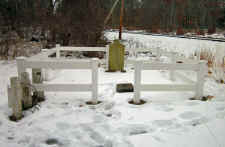 The old wood fence has been replaced with a vinyl fence. 1/11/2018 Photo: Dave Morrison
|
|||||||||||||||||||||
|
REV. PAUL CUFFEE, INDIAN PREACHER October 20,1949 by Thomas R. Bayles The Rev. Paul
Cuffee was the second of seven sons of Peter Cuffee, a native Indian of the Shinnecock tribe, and grandson, on his mothers side, of the Rev. Peter John. He was born in Brookhaven town probably at Wading River, on March 4, 1757. His mother was said to have been a very religious woman and for many years was a member of the Indian church at Wading River. At an early age he was bound out to major Frederick Hudson a farmer of Wading River with whom he lived and worked until he was 21 years of age. |
|||||||||||||||||||||||
 Project LIRR #39 driver tire 10/10/1980 Photo: Al Castelli Step #1 below |
 Project LIRR #39 driver tire 10/10/1980 Photo: Al Castelli Step #7 heated at about 450° Installation time approx. 50-60 minutes |
 Project LIRR #39 driver tire 10/10/1980 Photo: Al Castelli Step #9 below |
|||||||||||||||||||||
|
Steam locomotive tire heating at Morris Park shops 1954 Photo: Bill Rugen Archive: Art Huneke How to Apply Tires to Locomotive Wheels by Edward Kilsdonk Steam locomotives have large driving wheels, each of which is expensive and hard to repair. To preserve the wheels, locomotives use steel tires. The tires, which also have the flange that holds the train on the track, need to be replaced from time to time. Thus, things you'll need: heating collar, sledgehammer, and a hoist or crane. |
|||||||||||||||||||||||
|
Instructions: 1.
Remove the wheel from the locomotive by raising the locomotive on a crane,
disconnecting the driving rods, and then unbolting the wheel. Use an
engine hoist to move the wheel to a work stand that has been adjusted so
that the bottom of the wheel is at least a foot above the ground. 2.
Sweat the old tire off by heating it to about 200 degrees Fahrenheit and
then gently tapping it off with a heavy hammer. There are no physical
connections between the tire and the wheel, so you just need to expand the
tire a little. Be careful not to damage the sand-cast wheel 3.
Measure the wheel to the thousandth of an inch and order a new tire that
is about 55/1000 of an inch smaller than the wheel. Remember to measure
each wheel separately. 4.
Build a bracket and cradle to hold
the new tire next to and just above the wheel so that it can be sweated
on. This can be welded together out of scrap metal. The hanging bracket at
the top of the tire should hold the new tire firmly but not block the
movement of the new tire onto the wheel. 5.
Use a hoist to lift the new tire and position it next to the wheel. The
inner edge of the tire should be aligned with the outer edge of the wheel
at all sides, although you may want to cheat it up a few thousandths of an
inch to ease the final fitting. 6.
Wrap a heating collar around the new tire. Most collars run on propane. 7.
Heat the new tire to at least 300 degrees but no more than 600 degrees
Fahrenheit. This will enlarge the tire so that it will stretch and fit
over the wheel. 8.
Use a sledgehammer to fit the tire around the wheel by tapping the hot
tire on the side. You need the weight of the sledge to slide the tire
around the wheel, but be careful because you don't want to dent the tire
by hitting too hard. A two-hand grip with a moderate choke works best. 9.
Remove the gas ring and let the tire cool partway. As soon as the metal is
cool enough to approach, place C-clamps on the wheel and tire to keep the
tire from slipping sideways as it finishes cooling. 10. Use a tire lathe to trim excess metal from the new tire until the diameter of the new tire is within 3/32 of an inch of the diameter of the old tire. |
|||||||||||||||||||||||
|
MU Combine used as Office
Car MU combine #1356 had its electric trucks removed and replaced with non-electric trucks and was coupled onto a train and towed into position at the Port Washington station for use as an office car between 1950 and 1956 (Robert M. Emery data). This view looking northeast shows the car in place at Port Washington on September 18, 1951. Seven windows on the near side of the car appear to be fitted with screens. (Will Faxon photo, Dave Keller archive) |
|||||||||||||||||||||||
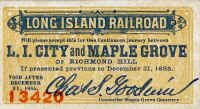 Ticket LI City to Maple Grove valid thru 12/31/1885 |
Ticket/History Maple Grove MAPLE GROVE : Opened: May/1879 as flag stop for Maple Grove cemetery. Closed: 1882. reopened: 1883. Removed in 1909 with realignment of tracks. moved approx. 600' south alongside new site of Kew station (which opened 9/8/1910) and perpendicular to tracks for use as real estate office for developers of Kew. Razed a short time later. KEW:
Opened: 9/8/1910 on re-aligned main line tracks south of ex-Maple Grove
station site. Renamed "KEW GARDENS": 1912 Notice the realignment "in-service" date matches the date of the first train run from Penn Station. . . . . That historic train was probably the first to operate "officially" along that realigned Main. Research: Dave Keller |
||||||||||||||||||||||
|
A rare LIRR ticket. Note the signature on the ticket is a cemetery official and not a LIRR General Passenger Agent. Also, the area that later became Kew Gardens was originally known as Richmond Hill. Hence, the 1950 LIRR horrible wreck at "Richmond Hill", which happened just east of the Kew Gardens station, was never called the Kew Gardens wreck but the Richmond Hill wreck. Richmond
Hill was the name of the surrounding town, but Maple Grove was the name of
the cemetery, and it had a depot for visitors to and from the cemetery.
The old depot at Maple Grove, no longer needed, was purchased by the realtor who was selling lots in Kew and was moved adjacent to the new Kew station (east side by the street overpass), set perpendicular to the north side of the tracks and used as a realty office for the land sales. Research: Dave Keller |
|||||||||||||||||||||||
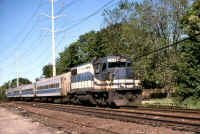 GP38-2 #254 and push-pull train #2008 eastbound at Greenlawn 5/22/98 Archive: Dave Keller |
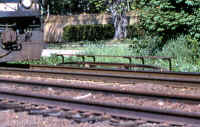 DM unit 3rd rail test section close-up Greenlawn 5/22/98 Archive: Dave Keller |
A short section of third
rail in non-electrified territory, complete with third rail protection
board on top: put into place to test the height of third rail contact
shoes on the newly-arrived DM (Dual Mode) units in 1999. It was there for
a short period (it was never electrified) and then removed as the tests
concluded. |
|||||||||||||||||||||
 LIRR "Training" consist 06/10/09 Photo: Dietrich Ryan |
Bicentennial Commemoration Emblem on GP38-2 - 1976 |
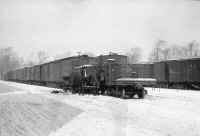 Team in yard at "Team Track" with Sleigh Rochester NY c.1910 |
|||||||||||||||||||||
 LIRR Retirement Watch |
|
||||||||||||||||||||||
 Crossing sign at Baylis Ave off Sheep Pasture Road View S P hoto: George Moraitis  Evergreen Branch Hancock St. 1998 Photo: Robert Anderson |
LIRR ticket Rail-Bus Printers error - Rail/Bus usage locations reversed Archive: Brad Phillips
|
 LI Express oval sealer from Montauk - Adams Express round sealer from Central Islip There were two types: One seal used for express business and one used for railroad business; such as ticket sales remittances. Both types had the station name on them. Some I've seen from the LIRR had only the station number like "Long Island Rail Road 59-1/2." The LI Express sealer has both the station name AND the station number (115 = 115 miles from LI City). Also, note that these
sealers were GIVEN to me by the clerk/block operator at Montauk in 1971 and
the agent/block operator at Central Islip around 1972. |
|||||||||||||||||||||
 "43 YEARS ON L.I.R.R. RINGHOUSE'S RECORD" Brooklyn Eagle March 13, 1909 |
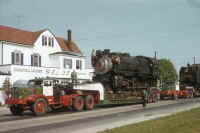 LIRR #35 en-route to Eisenhower Park, East Meadow, NY at Post Ave/Old Country Road 6/1956 Photo: Art Huneke 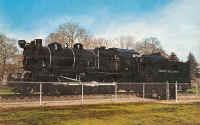 LIRR #35 Eisenhower Park post card Archive: William Gilligan 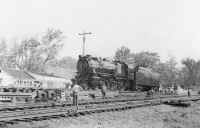 LIRR #39 loaded onto trailer to Stony Brook Carriage Museum 7/1956 |
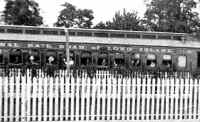  Central RR of LI Passenger Coach at Whitestone Landing c.1877 Archive: Dave Keller |
|||||||||||||||||||||
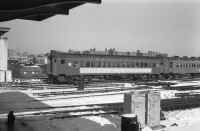 MU #4153 pulling westbound MU train into station, Jamaica, NY – “Ladies Day” sign on side of car: "LADIES YOU GET BARGAIN FARES TO NEW YORK ON WEDNESDAYS" Winter, 1957 Dave Keller archive Note: old marker lamp lying unattended on platform in foreground! |
 PRR Gas Car #4670 Transfer Table MP Shops 1935 Archive: Dave Keller |
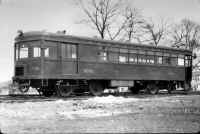 PRR Gas Car #4744 Wading River 1/1932 Photo: George Ayling Archive: Dave Keller |
|||||||||||||||||||||
|
|
|||||||||||||||||||||||
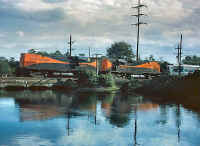 Cannonball Connetquot River eastbound |
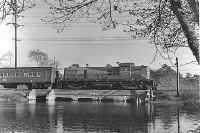 Connetquot River westbound 1968 Photo: J. P. Krzenski, Dave Keller Archive |
 Connetquot River eastbound 1970 Photo: Joe Korman |
 LIRR train #8709 - Connetquot River 6/05/2022 Photo/Archive: Ronnie Schnepf |
||||||||||||||||||||
|
|
|||||||||||||||||||||||
 Car wash interior - W. Islip 11/1977 Archive: Mike Robbins |
|
||||||||||||||||||||||
|
|
|||||||||||||||||||||||
|
Despite the two
powered locomotives, this was not really a Push-Pull situation. The spur
had no runaround track, so trains entering had to back out, then run empty
to Ronkonkoma where they ran around the train on the wye and laid-up for
the return trip in the afternoon. In later years, such as in this
view, they ran with two engines. One would pull the train onto the
spur and up to the station. The other would pull the train out of
the spur and all would run to Ronkonkoma for layup. The loco on the
east end would run around and couple to the west end and when back at
Pilgrim, the train would back onto the spur up to the station, pick up
passengers and then double-head out westward as the engine served no
purpose on the rear of the train. (William Madden photo, Dave
Keller archive) |
|||||||||||||||||||||||
| Dietz Lamps | |||||||||||||||||||||||
 Dietz Lamps at LIRR Mattituck Depot c. 1905 Archive: Dave Keller
|
 Established 1840, these lamps were used throughout the South Side Rail Road and LIRR 1902 Dietz Post Oil Lamp No.3 ad. Archive: Dave Keller
|
 Dietz Post Oil Lamp No.3 metal ladder support rods 1902 Archive: Dave Keller |
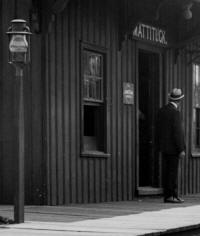 Dietz Lamp - Mattituck Depot zoom View SW c.1905 Archive: Dave Keller
|
||||||||||||||||||||
 Dietz Post Oil Lamp - Floral Park 1913 zoom Archive: Dave Keller |
 Dietz No.3 Post Oil Lamp - Pioneer Globe |
Electric lamps in use as
early as 1903 and kerosene lamps used as late as 1943. For example:
Glen Cove electric platform lamps in 1903 (probably installed as
members of the Country Club nearby). |
|||||||||||||||||||||
|
|
|||||||||||||||||||||||
 LIRR "Last Run" Retirement Watch 11/01/2006 Owner/Photo: Robert S. Anderson |
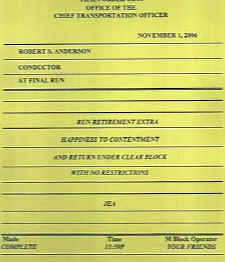 Robert Anderson "Last Run" Train Order 11/01/2006 Owner/Photo: Robert S. Anderson |
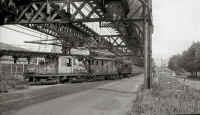 South Brooklyn Railway Steeple cab electric locomotive #5 and box cab electric motor #4 pulling idler car and a string of new BMT R-10 cars along McDonald Ave. southbound past the Coney Island Shops. View is northwest. The BMT Culver Line is overhead and the BMT Avenue X station is visible in the center background - 1947 (Dave Keller archive) |
|||||||||||||||||||||
| Long Island Rail Road - Odds & Ends - Page 2 | |||||||||||||||||||||||
|
Puzzle
Names Answer: Bonus: Dix Hills, Plainview, Franklin Square, and Elwood |
|||||||||||||||||||||||
01/02/2026

